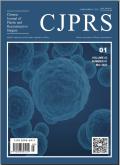女性腰动脉穿支皮瓣的解剖CT研究
Chinese Journal of Plastic and Reconstructive Surgery
Pub Date : 2025-06-01
DOI:10.1016/j.cjprs.2025.02.001
引用次数: 0
摘要
背景:腰动脉穿支皮瓣是乳房再造术中重要的自体皮瓣。由于腰椎穿支皮瓣在该领域相对较新,关于术前准备的几个问题仍然存在,特别是关于供区计算机断层扫描(CT)和磁共振成像。本研究的目的是通过精确确定腰椎穿支的特征来帮助女性患者的LAP皮瓣手术入路。方法回顾性分析20例腰动脉穿支位置的ct血管造影图像。研究了四个特征:长度、直径、腰椎椎弓根的路径和可供移植的组织的厚度。结果分析20张CT图像,发现腰动脉穿支149条。最适合皮瓣收获的穿支是L4穿支,它具有更大的直径,更多的穿支体,以及更高比例的皮肤-间隔束。结论LAP皮瓣是女性乳房再造术的一种可行的选择。L4穿支动脉因其优越的灌注能力、直径和路线而最适合采集;然而,可能需要插入移植物来延长血管蒂。本文章由计算机程序翻译,如有差异,请以英文原文为准。
Anatomical CT study of lumbar artery perforator flap in women
Background
The lumbar artery perforator (LAP) flap is an important autologous option in breast reconstruction. As the lumbar perforator flap is relatively new in this field, several questions remain regarding preoperative preparation, especially concerning computed tomography (CT) and magnetic resonance imaging of the donor site. The objective of this study was to aid the surgical approach to the LAP flap in female patients by precisely determining the characteristics of the lumbar perforators.
Methods
We retrospectively reviewed the computed tomographic angiography images of 20 patients who underwent evaluation of the perforator positions from the four lumbar arteries. Four characteristics were studied: length, diameter, path of the lumbar pedicle, and thickness of the tissues available for transfer.
Results
We analyzed 20 CT images, identifying 149 perforating vessels of the lumbar artery. The most suitable perforator for flap harvesting was the L4 perforator, which exhibited a larger diameter, a greater number of perforasomes, and a higher percentage of the cutaneous-septal tract.
Conclusion
The LAP flap is a viable option for breast reconstruction and as a free flap in women. The L4 perforator artery is the most suitable for harvesting, owing to its superior perfusion capacity, diameter, and course; however, an interposition graft may be required to lengthen the vascular pedicle.
求助全文
通过发布文献求助,成功后即可免费获取论文全文。
去求助
来源期刊

Chinese Journal of Plastic and Reconstructive Surgery
Surgery, Otorhinolaryngology and Facial Plastic Surgery, Pathology and Medical Technology, Transplantation
CiteScore
0.40
自引率
0.00%
发文量
115
审稿时长
55 days
 求助内容:
求助内容: 应助结果提醒方式:
应助结果提醒方式:


